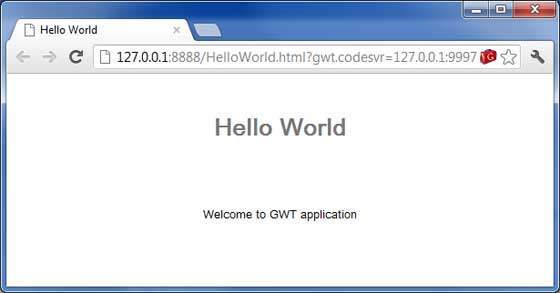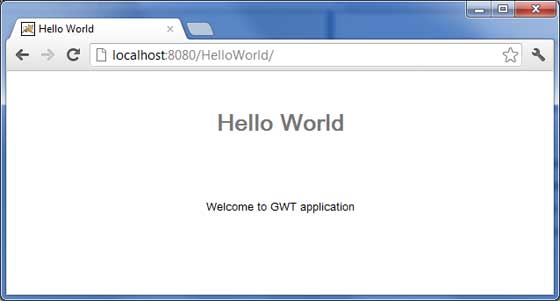
- GWT 教程
- GWT - 主页
- GWT - 概述
- GWT - 环境设置
- GWT - 应用
- GWT - 创建应用程序
- GWT - 部署应用程序
- GWT - 使用 CSS 的样式
- GWT - 基本小部件
- GWT - 表单小部件
- GWT - 复杂的小部件
- GWT - 布局面板
- GWT - 事件处理
- GWT - 自定义小部件
- GWT-UIBinder
- GWT - RPC 通信
- GWT - JUnit 集成
- GWT - 调试应用程序
- GWT-- 国际化
- GWT - 历史课
- GWT - 书签支持
- GWT - 日志框架
- GWT 有用资源
- GWT - 问题与解答
- GWT - 快速指南
- GWT - 有用的资源
- GWT - 讨论
GWT - 部署应用程序
本教程将向您解释如何创建应用程序“war”文件以及如何将其部署到 Apache Tomcat Websever 根目录中。
如果您理解这个简单的示例,那么您还可以按照相同的步骤部署复杂的 GWT 应用程序。
让我们将可用的 Eclipse IDE 和 GWT 插件安装到位,并按照以下步骤创建 GWT 应用程序 -
| 步 | 描述 |
|---|---|
| 1 | 按照GWT - 创建应用程序章节中的说明,在com.tutorialspoint包下创建一个名为HelloWorld的项目。 |
| 2 | 如下所述修改HelloWorld.gwt.xml、HelloWorld.css、HelloWorld.html和HelloWorld.java 。保持其余文件不变。 |
| 3 | 编译并运行应用程序以确保业务逻辑按照要求运行。 |
| 4 | 最后,将应用程序的war文件夹中的内容以war文件的形式压缩并部署到Apache Tomcat Webserver中。 |
| 5 | 使用适当的 URL 启动您的 Web 应用程序,如下面最后一步中所述。 |
以下是修改后的模块描述符src/com.tutorialspoint/HelloWorld.gwt.xml的内容。
<?xml version = "1.0" encoding = "UTF-8"?> <module rename-to = 'helloworld'> <!-- Inherit the core Web Toolkit stuff. --> <inherits name = 'com.google.gwt.user.User'/> <!-- Inherit the default GWT style sheet. --> <inherits name = 'com.google.gwt.user.theme.clean.Clean'/> <!-- Specify the app entry point class. --> <entry-point class = 'com.tutorialspoint.client.HelloWorld'/> <!-- Specify the paths for translatable code --> <source path = 'client'/> <source path = 'shared'/> </module>
以下是修改后的样式表文件war/HelloWorld.css的内容。
body {
text-align: center;
font-family: verdana, sans-serif;
}
h1 {
font-size: 2em;
font-weight: bold;
color: #777777;
margin: 40px 0px 70px;
text-align: center;
}
以下是修改后的 HTML 主机文件war/HelloWorld.html的内容。
<html>
<head>
<title>Hello World</title>
<link rel = "stylesheet" href = "HelloWorld.css"/>
<script language = "javascript" src = "helloworld/helloworld.nocache.js">
</script>
</head>
<body>
<h1>Hello World</h1>
<div id = "gwtContainer"></div>
</body>
</html>
我对前面示例的 HTML 做了一些修改。在这里,我创建了一个占位符 <div>...</div>,我们将使用入口点 java 类在其中插入一些内容。因此,让我们拥有 Java 文件src/com.tutorialspoint/HelloWorld.java的以下内容。
package com.tutorialspoint.client;
import com.google.gwt.core.client.EntryPoint;
import com.google.gwt.user.client.ui.HTML;
import com.google.gwt.user.client.ui.RootPanel;
public class HelloWorld implements EntryPoint {
public void onModuleLoad() {
HTML html = new HTML("<p>Welcome to GWT application</p>");
RootPanel.get("gwtContainer").add(html);
}
}
在这里,我们创建了基本的最宽 HTML,并将其添加到 id="gwtContainer" 的 div 标签内。我们将在接下来的章节中研究不同的 GWT 小部件。
准备好完成所有更改后,让我们在开发模式下编译并运行应用程序,就像我们在GWT - 创建应用程序章节中所做的那样。如果您的应用程序一切正常,这将产生以下结果 -

创建 WAR 文件
现在我们的应用程序运行良好,我们准备将其导出为 war 文件。
请按照以下步骤操作 -
进入项目的war目录C:\workspace\HelloWorld\war
选择 war 目录中可用的所有文件和文件夹。
将所有选定的文件和文件夹压缩到名为HelloWorld.zip的文件中。
将HelloWorld.zip重命名为HelloWorld.war。
部署 WAR 文件
停止 tomcat 服务器。
将HelloWorld.war文件复制到tomcat安装目录> webapps文件夹中。
启动 tomcat 服务器。
查看 webapps 目录,应该有一个文件夹helloworld已创建。
现在HelloWorld.war已成功部署在Tomcat Web服务器根目录中。
运行应用程序
在 Web 浏览器中输入 url:http://localhost:8080/HelloWorld以启动应用程序
服务器名称 (localhost) 和端口 (8080) 可能会根据您的 tomcat 配置而有所不同。
